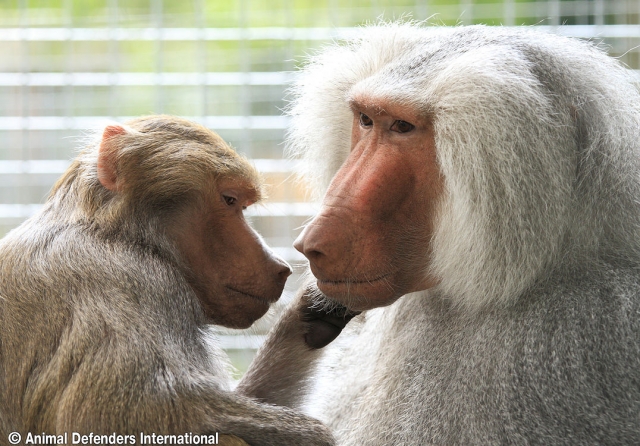
Tilin and Tina
Theyve Backed The Macaque! Endangered Primates Granted Highest Level Of Protection
Animal Defenders International (ADI) applaud the announcement from CITES conference (Convention on International Trade in Endangered Species) in Johannesburg, that the committee has unanimously voted for the endangered Barbary macaque to be uplisted to Appendix I, ensuring the highest level of wildlife protection. The process still requires final plenary review, however, given the outpouring of support a positive outcome is highly likely.
The news came following a campaign from ADI with support from the public, governments and musician Moby. This will go a long way to help protect the Barbary macaque, Europe’s only native primate species, from illegal traders who tout individuals as pets and photo props.
The 183 countries which are signatories to the CITES trade restrictions decide in Johannesburg which species need further protection, and which species will endure further killing and trade. Species covered by CITES are listed by Appendices I (highest level of protection), II and III, according to the level of risk to survival of the species.
In an almost unprecedented move, all range States and the main consumer countries providing the market for these animals have rallied together behind a joint Morocco-EU proposal and a call from animal protection groups to transfer the species to Appendix I.
Animal Defenders International President Jan Creamer says: “Illegal trade of the Barbary macaque was pushing these little monkeys to the brink, so we are delighted that action has been taken before it’s too late. Please never pose for images with captive wild animals, who are ripped from the wild and denied their freedom so they can be used as tourist photo props.”
Gerben Jan Gerbrandy, Member of the European Parliament for D66 and Head of the European Parliament Delegation to CoP17, agrees on the importance of this moment: “The adoption of the joint proposal from the EU and Morocco would be a key next step in protecting a species for which the EU is unfortunately a key destination market. Now we have to make sure that any agreement is properly and coherently enforced to the fullest effect. That is where the real difference will be made.”
ADI supported the proposal to uplist Barbary macaque populations to Appendix I of CITES, ensuring they receive the highest level of protection. Ahead of the successful proposal, animal lover Moby said: "I refuse to stand by and do nothing as these endangered monkeys are snatched from the wild and their families for photo props and the pet trade. Barbary macaques need our urgent help and I hope governments will join ADI and 'back the macaque' and grant them the greater protection they need".
Once widespread throughout Northern Africa, Barbary macaques now have only isolated populations in the mountains of Algeria and Morocco, as well as Gibraltar where the monkeys were introduced. The only primates native to Europe, the Barbary macaque’s overall population has plummeted 50% over three generations (24 years), with numbers crashing to as low as 6,500 individuals. In the central Middle Atlas region of Morocco, the global stronghold of the species, average population density has declined by a shocking 50-80% over the last 30 years.
Highly intelligent, emotional and sensitive, Barbary macaques live up to 22 years of age, in social groups comprising as many as 80 individuals, with males playing a primary role in caring for their young. They prefer high altitude cedar forests, but can also be found in oak forests, coastal scrub, and rocky slopes, feeding on fruits, tree leaves, and plants.
Despite their endangered status under the Convention on International Trade in Endangered Species (CITES), Barbary macaques are often taken illegally from the wild for the pet trade or to be used as photo props for tourists. Barbary macaques are in fact the most seized CITES mammal in the EU, accounting for 25% of official seizures of live mammals.
Having campaigned for over 20 years to educate the public about the use of primates for entertainment, research, and as pets, exposing the huge numbers of animals taken from the wild each year and the suffering of the animals during captivity and transport, the plight of the Barbary macaque is a cause close to ADI’s heart.
Last year, ADI rescued more than 30 illegally traded monkeys in Peru during an 18-month mission against wildlife trafficking and to enforce a ban on wild animals in circuses. Over 100 animals were saved during the operation. Having nursed the monkeys back to health, ADI relocated new family groups from six different primate species to sanctuaries in their native Amazon habitats where ADI continues to fund their care for life
https://www.secure.adi-navs-ldf.org/donate.asp?id=1423&cachefixer=
ADI previously rescued two Hamadryas baboons – one from a Bolivian circus and the other from the pet trade in Cyprus. They now live happily together at the Lakeview Monkey Sanctuary in the UK, where ADI funds their care for life, along with three macaques born at the notorious and now closed Israeli monkey breeder Mazor Farm. Born to wild-caught parents, Baloo, Betty and Boo were sold to a European research laboratory and used in neurology experiments. When the monkeys were no longer required, ADI stepped in to save them from being killed.
More from Animal Defenders International
- Laboratory monkey breeding factory farms still taking animals from the wild
- Wild animal circus ban PASSED in UK Parliament
- New Welsh Government bill will ban wild animal circuses
- Is that fur real? Concerned public invited to check their faux fur items
- First big cats SAVED by UK organisation following Guatemala circus ban

 9 years ago
9 years ago  1282 views
1282 views
